|
Getting your Trinity Audio player ready...
|
The year is 1205. The young Francis kneels before Our Lord in the humble chapel of San Damiano in the Umbrian valley, where he had taken refuge from the world. Francis later reflected on this encounter, praying: “We adore you, Lord Jesus Christ, in all your churches throughout the world, and we bless you, because by your Holy Cross you have redeemed the world.”
In these simple yet profound words, we have a true reflection of Francis, a man of prayer. The little poor man of Assisi, steeped in the Liturgy of the Church, had borrowed these words from the sacred liturgy of the Lord’s Passion on Good Friday. As I said elsewhere, quoting St. Francis’ most excellent recent biographer Fr. Augustine Thompson, O.P., “The issue he found most pressing was not poverty, not obedience, but proper reverence for the Eucharist.”
I continued to reflect that St. Francis’ most pressing issue was
Orthodox. Faithful. Free.
Sign up to get Crisis articles delivered to your inbox daily
Not immigration, starvation, dehydration, disease, global warming, ecology, or endangered species (unless it be the endangered species of bread and wine unworthily treated); not faux obedience to apostolic exhortations, brain-fever fervorinos, or councils of cardinals; but proper reverence for the Lord in His true Body and Blood, expressed through the careful and devout offering of the Mass, the most worthy vessels and vestments one can supply, signs of adoring love, and an unyielding insistence on penance and renunciation of sin prior to communion. This is what St. Francis believed in; this is what he stood for; this is what his order was meant to believe, say, and do.
Unbeknownst to many outsiders, in 2016 Franciscan University of Steubenville had agreed with McCrery Architects to build a brand-new chapel in the center of campus. This design involved years of planning and was approved by the university president at the time with the guidance of a large committee of well-established theologians and experts in sacred art.
The McCrery proposal takes one’s breath away by its sheer stunning beauty, its fittingness for the sacred liturgy, its perfect conformity to the highest ideals of Catholic art, and its harmony with the spirit of Eucharistic reverence that animated St. Francis himself. Here are some images of what the committee agreed upon:
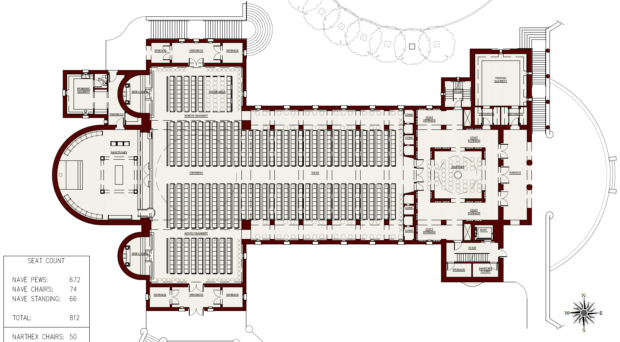
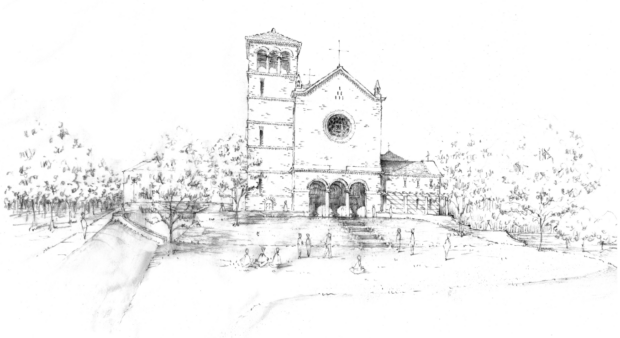

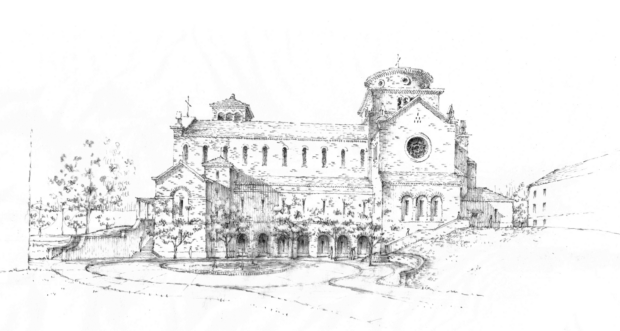
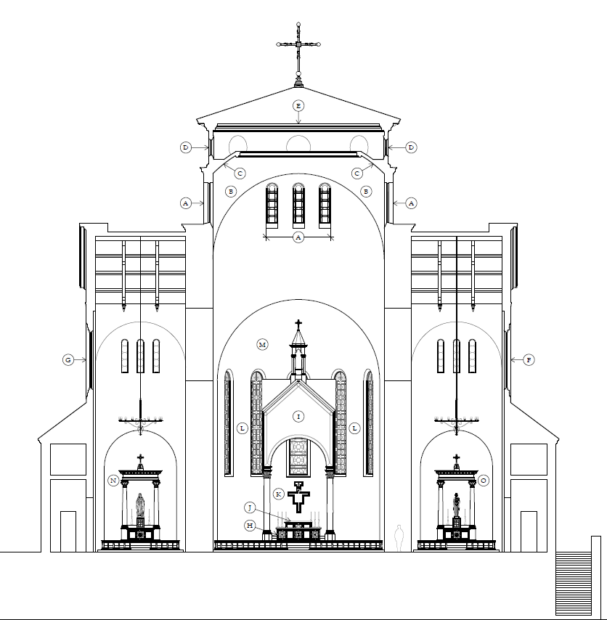
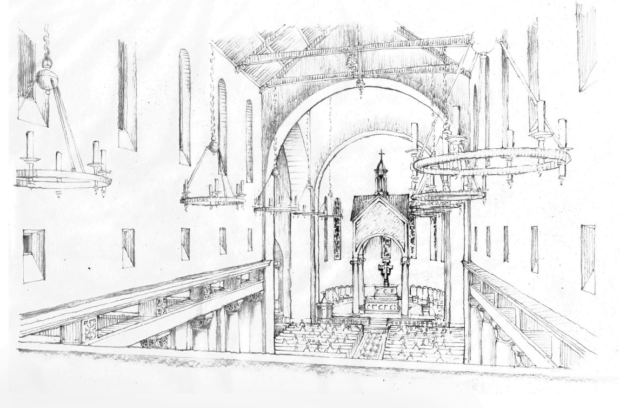
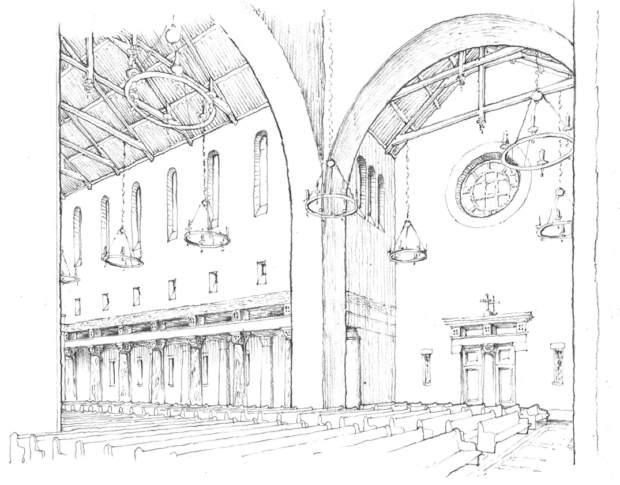
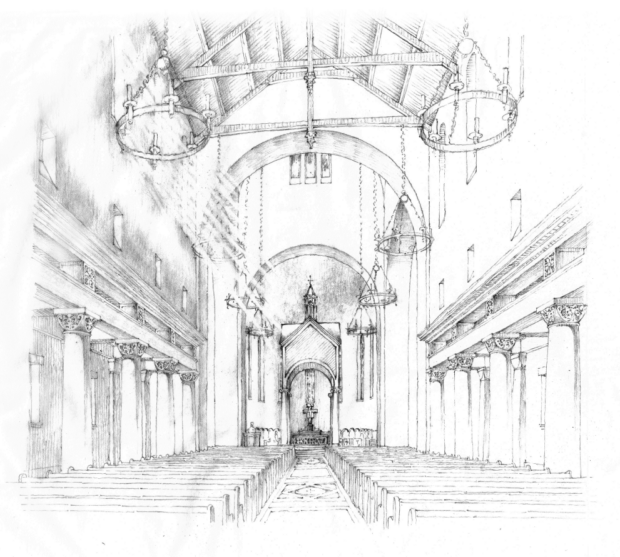
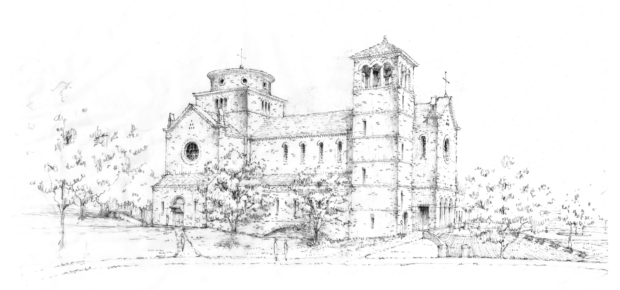
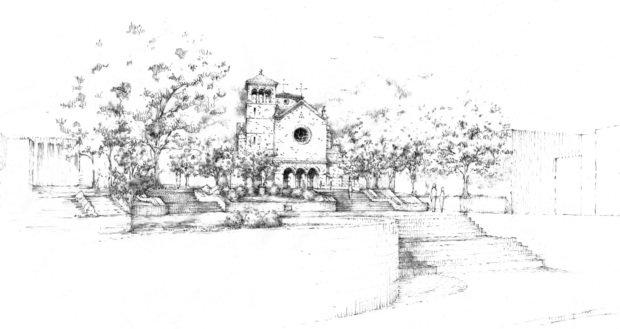
The architect described the project as follows:
This Chapel is designed to meet the needs of a growing and flourishing student body, by doubling in seating capacity to 600, with the potential to hold 1000, and by providing a beautiful chapel to foster the richness of the spiritual life on campus. The design is inspired by and participates in the tremendously rich Romanesque artistic and architectural tradition. It draws from architectural forms that Saint Francis knew in the Umbrian countryside…
Appended to the chapel’s overall cross-shaped form are various necessary components: two sacristies, a bell tower, a stair tower, and two further entrance vestibules. Each of these, along with a lower level arcade that opens to the ground level on the north side, assist in marrying the chapel to its landscape. The chapel’s significance is further indicated by a tower at the crossing, surmounted by a circular drum and capped by a conical roof.
This three-dimensional composition arrays the faithful within a traditional form and orients them heavenward. In this sense, the chapel is a physical realization of the university’s mission at the very heart of campus.
This proposal contains many of the elements that mark a sacred space, such as the general plan of the church being cruciform and basilican as opposed to the “eclipse” form of the current chapel. As for the sanctuary, the key components point to the sacredness of the Holy Sacrifice of the Mass, with a ciborium magnum—or baldachin—to highlight the importance of the altar. There is a communion rail for the reverent reception of Holy Communion as well as to mark a clear distinction between the nave and the sanctuary.
All this was perfectly in accord with the wishes of Franciscan’s various constituencies. The former president, Fr. Sean Sheridan, had sent out a detailed questionnaire to all students, staff, faculty, and administration, asking them about priorities for the (then) capital campaign. There were a handful of questions about a chapel and the overwhelming majority expressed a desire for a new chapel designed in a traditional architectural style. Tradition and the vox populi aligned, in perfect accord with the sensus fidelium.
The magnificent McCrery plan, which draws upon the riches of Catholic and Franciscan history in aspiring to build an icon of the heavenly Jerusalem, was unceremoniously discarded with the arrival of the new president, Fr. Dave Pivonka, in 2019. Inside sources say that he favored building a more modern worship space or revamping the existing space. Unlike his predecessor, Fr. Pivonka did not send out any kind of poll to gauge what his constituencies would wish to see—perhaps because the results could be too easily predicted.
In fact, he didn’t even make a public announcement about tabling the former chapel plans. McCrery Architects learned only through the grapevine that the project had been suspended. The FUS administration made this major course shift without ever properly informing the faculty, staff, students, alumni, and even the architectural firm about the decision to alter the plans for the chapel.
Last week, on October 4, the Feast of St. Francis of Assisi, Franciscan University of Steubenville announced plans for a $12 million “renovation” of its existing Christ the King Chapel. The new project will add roughly 100 seats to the current chapel and will not serve the students’ best interests in the future—all for a steep figure of over $1,000 per square foot.
Christ the King Chapel, however beloved it may be to individuals who have worshiped there, is not and never will be included in any coffee-table book of “America’s most beautiful churches.” No one could point to it and say: “Ah, now that is an exemplar of the Catholic and Franciscan spirit.” There’s a reason the Gothic church that graces FUS’s study-abroad campus in Gaming, Austria, is splashed in brochures and emblazoned in a large photograph in the library!
Let’s be frank: Christ the King Chapel is an embarrassing relic from a period of time when ugly churches were the norm, when the overarching rule was to avoid anything that looked traditional. It emphasizes a modern “spirit of the Council” that now looks and feels terribly dated. No one really wants this anymore, and the fact that most major church projects in the United States have been, for a long time now, Romanesque, Gothic, Renaissance, or Baroque in style points to the influence of John Paul II and Benedict XVI in reorienting the Church to her own distinctive identity and timeless, time-honored nature.
The decision to change architectural plans was made by the university president and a few individuals who have no credentials in sacred architecture and liturgical theology. Additionally, we know that if students and alumni were polled, there would be a strong interest in traditional Catholic architecture and theology—e.g., communion rails, patens under the chin, and ad orientem worship. The students, faculty, staff, alumni, and most importantly, Our Lord Himself, deserve a sacred space oriented to right worship, “for the conversion of sinners and for the liberty and exaltation of our holy Mother the Church.” The decision to change architectural plans was made by the university president and a few individuals who have no credentials in sacred architecture and liturgical theology. Tweet This
“Where your treasure is,” says Jesus, “there will your heart be also.” We can tell where a people’s heart dwells by where and how they place their treasure. FUS is completing construction of the new Christ the Teacher Academic Building, which cost $59 million. Additionally, the university has announced the raising of the total of their capital campaign to $110 million. Meanwhile, other Newman Guide schools such as Christendom College and Thomas Aquinas College have completed chapels that are beautiful temples fitting for worship. How shameful it would be if FUS turned out to be the only one of the three original Newman Guide schools to lack a chapel suitable for divine worship.
There is no doubt the money would pour in for such a noble and inspiring project. It did for the award-winning chapel designed by Duncan Stroik for Thomas Aquinas College. It did for the impressive new chapel designed by O’Brien & Keane for Christendom College. It would not be lacking for Franciscan University of Steubenville if they embraced McCrery’s design. It is not too late to reverse gears and back away from an ill-considered plan. FUS can still choose to build a memorable, iconic, tradition-saturated chapel on campus, in accordance with a proposal already developed and ready for action.
Readers who wish to send a short, respectful, positive letter to Fr. Pivonka expressing their support for the McCrery chapel design (and, if it is possible for you, pledging financial support for it) may use the following address:
Fr. David Pivonka, TOR
Franciscan University
1235 University Blvd.
Steubenville, OH 43952
